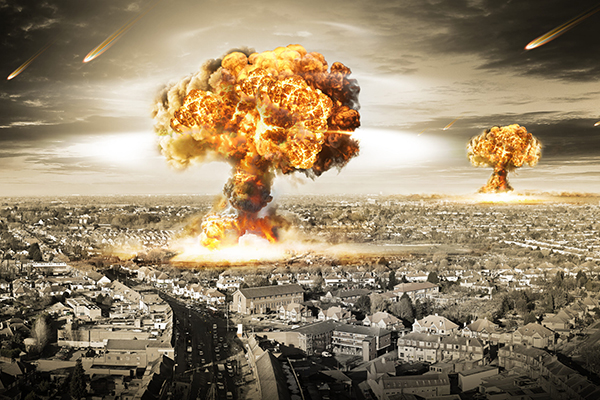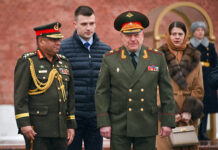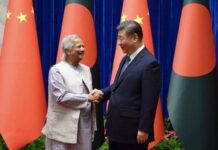
Russia’s Nuclear Operations – Part 1
In a televised address to the Russian people on 21 September, Putin explicitly raised the specter of a nuclear conflict. Despite being regarded as a very low likelihood scenario, the potential implications of such a scenario are huge.
This article tries to give the reader-at-large an idea about what is involved in launching a tactical nuclear strike.
The push for partial mobilization is bound to escalate the situation in Ukraine. Losses are mounting exponentially and with the influx of inexperienced conscripts who lack any meaningful knowledge of the weapon systems would further make the situation even more dire.
There is no justification to use nuclear weapons in a conflict with a non-nuclear state. But according to Russia, the only feasible way to put an end to the conflict is to use nuclear weapons. The chances of a nuclear device detonation have become uncomfortably high.
Russia’s Strategic Rocket Forces possess a wide variety of nuclear weapons platforms and devices. Russia currently has approximately 6000 warheads. They vary in their yield and the safety mechanisms. Most of the devices are equipped with a standard dialable yield system, which according to the target can be adjusted. They also possess a wide variety of platforms to deliver the said devices ranging from ICBMs to artillery shells.
As per the Russian state, current conflict would call for the use of tactical nuclear weapons to deter Ukrainian advances all the up to the border of Russia. The most important factor is the launch time preparedness. The long range ballistic missiles are at the highest level of readiness. The inherent problem of long range liquid fueled missiles meant that they had to be fueled immediately before launch, this was solved by the R-36 series which were fueled only once, when they are placed in the silos. After that the missiles are ampulised/sealed and kept in this state ready for launch. As a result, the time needed to wind up the guidance system’s gyroscopes became the main constraint on launch readiness rather than the several hours that the missile previously needed to launch.
R-36M missiles were the first liquid-fuel missiles that used a so-called cold launch method, in which the missile main engine did not start until the missile had been ejected from the silo by a special charge: a pressure accumulator. This launch method reduced the heat and acoustic load on the missile and allowed the fuller use of silo volume.
The development of the automated system of combat management and the introduction of third-generation missile systems with on-board computers provided the RVSN the technological capacity to remotely alter missile flight assignments and alter nuclear force use scenarios in response to changing circumstances. Since the flight trajectory of missiles moving along the combat route must constantly be recalculated as the location of the launchers changes, the adoption of fourth-generation systems (the R-36M2, RT-23UTTH, and Topol) provided the capability for quick retargeting, which was crucial in the case of mobile systems. Therefore, there were no new technological challenges while changing the targeted coordinates.
During the pre-war time silo-based missiles would have been reprogrammed with “neutral” flight assignments (aimed at targets in the ocean). Fourth-generation systems are now on combat duty with zero flight assignments. These changes were largely symbolic, however, because it takes no more than a few minutes to retarget systems in accordance with operational plans for their use.
It is the tactical systems that require more time for getting ready to be deployed on the battlefield. Russia has many of them. The warhead must be prepared, mated to the desired platform (usually cruise missiles but in some cases smaller warheads can be mated to the S-300/400 series to deny the airspace to the enemy).
From transporting the warhead to the location, calibrating the gyroscopes (if the device has them), programming the detonation yield, testing the on board power system and finally mating the device to the platform on the appropriate bus. This will take several hours and will be detected by satellites, drones and people.
For instance, if Russia wishes to deploy the Nuclear weapon from a ground based launcher to detonate above the Black Sea/forward areas of Donetsk. It is highly likely the platform of choice is going to be a Mig-31. It is important to know that the control of the missile launch will be remote and may not be in the hands of the pilot.
If they choose to use a ground based launcher(static or mobile), it is highly likely the following steps will be followed :
1. The General Staff gives the proper directives to the armed forces’ services regarding the use of nuclear weapons when the decision to use nuclear weapons has been taken and the precise scenario for their use has been determined.
2. The Central Command Center of the General Staff (which serves as the Supreme High Command Central Command Center) transmits the necessary authorization codes and unlocks certain launchers to issue the command to employ nuclear weapons.
3. The combat management signal for the Rocket Forces initially travels to the Strategic Rocket Forces Central Command Center before being forwarded to the regiments whose launchers are to be employed.
4. The on-duty staff must input the authorizing codes and launch the missiles when the order to employ weapons and the authorizing codes have been sent. The command and control system also allows for the capability of firing missiles without the involvement of personnel on lower levels directly from the Supreme High Command Central Command Center.
5. Automated launch preparations begin as soon as the launcher receives the launch command. The response time—the period of time between the transmission of the launch command and the actual launch—depends on the missile and launcher, as well as their condition at the moment the command is received.
6. Prior to launch, the missile’s guidance system must be activated (the switch to onboard power supply, the activation of the gyros, etc.), and the first-stage propulsion system (or the pressure accumulator in a cold-launch system) must be ignited.
7. When the launch command is received, the transporter-launcher (ground or rail) stops, the launcher is secured in the soil with hydraulic supports, and the canister containing the missile is raised to a vertical position. After this, the pressure accumulator is ignited and the missile is fired from the canister.
Part 2 will cover the launch to detonation and aftermath

















